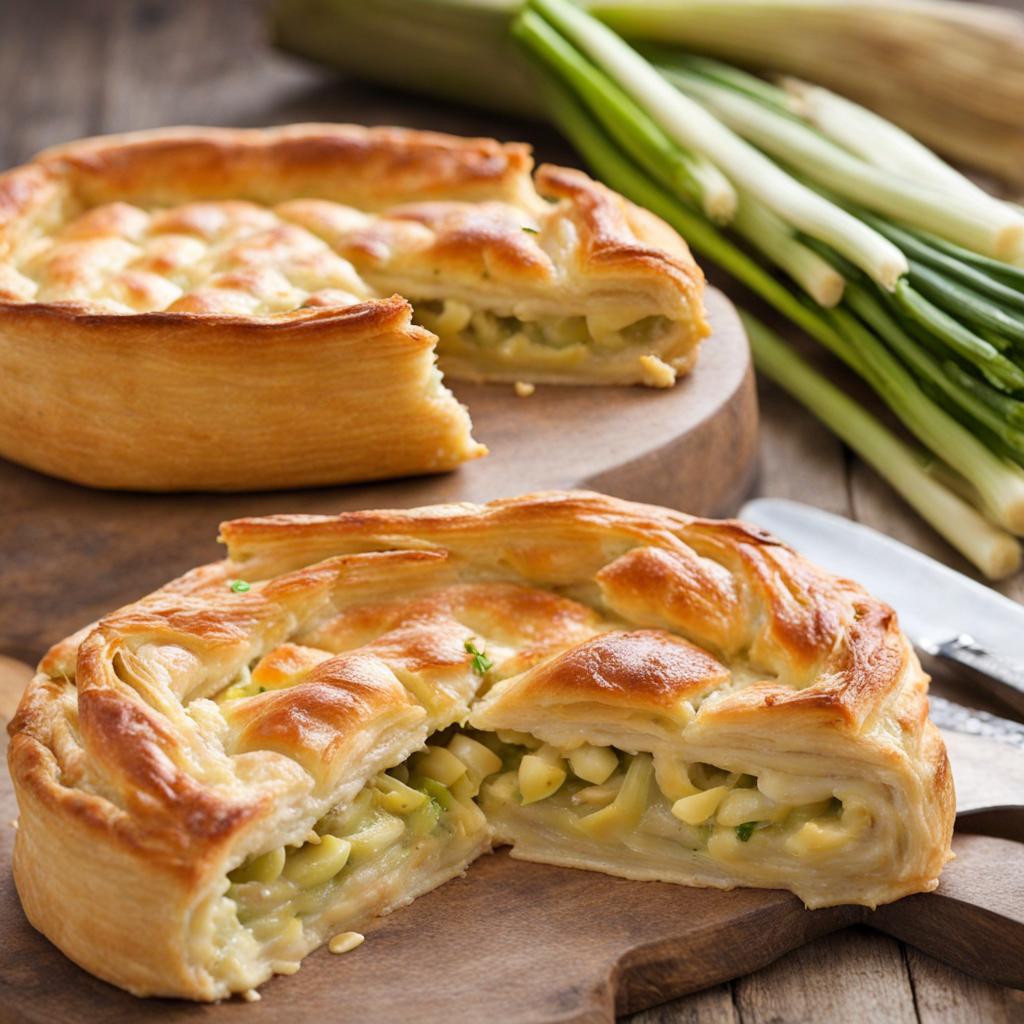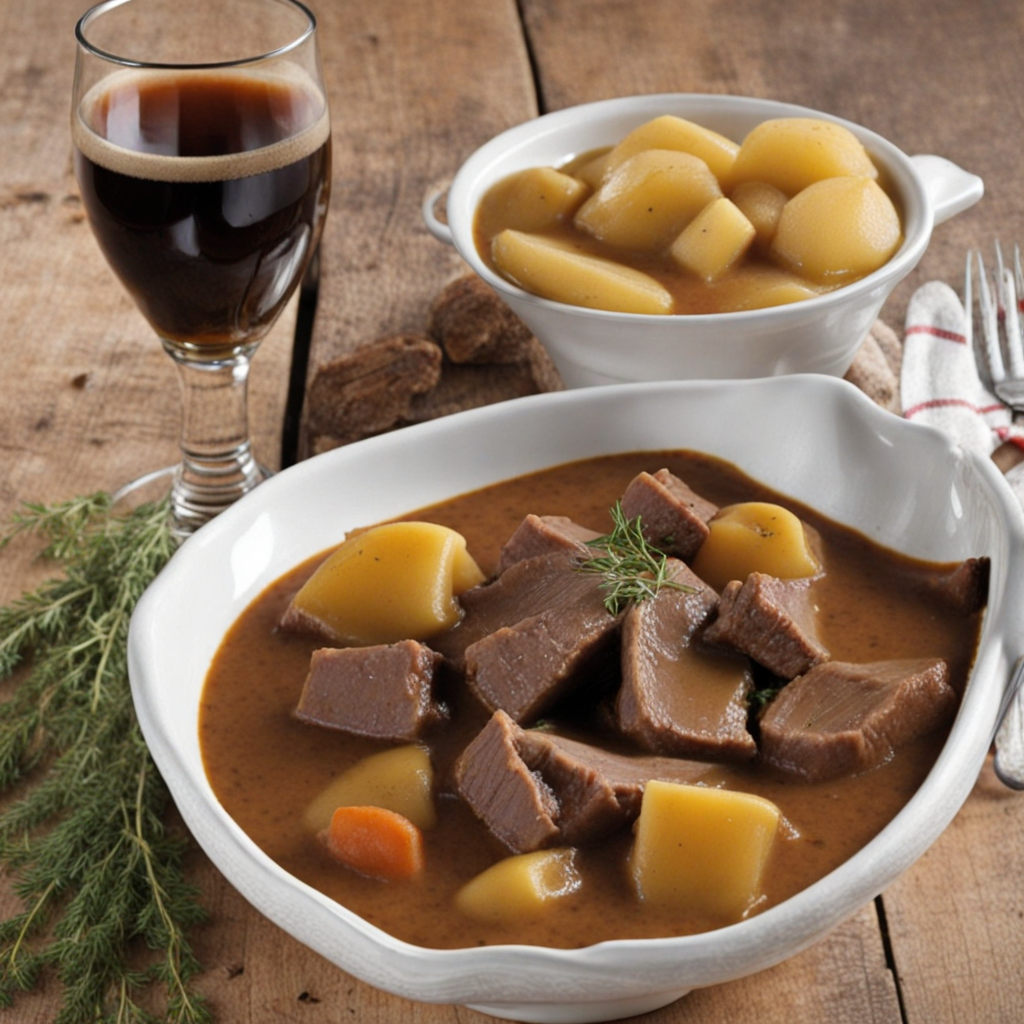Flamiche
Flamiche is a delightful dish hailing from the Walloon region of Belgium, particularly known for its rich and savory flavors. At its core, flamiche is a type of savory pie or tart that typically features a crisp, flaky pastry crust filled with a luscious mixture of cream, cheese, and often leeks or onions. The combination of the creamy filling with the gentle sweetness of the cooked leeks creates a harmonious balance that is both comforting and satisfying, making it a popular choice for a cozy meal or a casual gathering with friends and family. One of the most appealing aspects of flamiche is its versatility; while the traditional version highlights leeks and a blend of local cheeses, variations can incorporate other ingredients such as mushrooms, herbs, or even seasonal vegetables. This adaptability allows home cooks and chefs alike to put their own spin on the dish, showcasing the flavors of the region and the bounty of local produce. Whether served warm or at room temperature, flamiche is an inviting dish that beckons to be shared over good conversation. The texture of flamiche is equally enticing, with the buttery, golden crust cradling the velvety filling that melts in your mouth. Often enjoyed as a starter or a main dish, it pairs beautifully with a simple green salad or a side of roasted vegetables. The experience of savoring flamiche is not just about taste; it’s also about enjoying the rich culinary traditions of Belgium, making it a must-try for anyone looking to explore new and exciting flavors.
How It Became This Dish
Flamiche: A Culinary Journey Through Belgium Flamiche, a delectable dish originating from the Walloon region of Belgium, is a savory pie that embodies the rich culinary heritage of the area. With its creamy filling encased in a buttery crust, flamiche is more than just food; it is a reflection of the cultural, agricultural, and historical influences that have shaped Belgium's gastronomic landscape. This essay seeks to explore the origin of flamiche, its cultural significance, and its development over time. Origins of Flamiche The roots of flamiche can be traced back to the Picardy region of France, particularly in the towns bordering Belgium, such as Lille and Arras. The word "flamiche" itself is derived from the Old French term "flameche," which refers to a pastry or pie. The dish is traditionally made with a filling of leeks, cream, and cheese, encased in a flaky crust. The use of leeks is particularly emblematic of the region, as they have been cultivated in northern France and Belgium for centuries. Historically, flamiche was a dish born out of necessity. In a time when food preservation was crucial, farmers and households utilized ingredients that were readily available. The combination of leeks and cream was a practical choice, as leeks are hardy vegetables that can be harvested late into the fall and winter months. The cream, often sourced from local dairies, added richness to the dish, making it both satisfying and nourishing. Cultural Significance Flamiche holds a significant place in the culinary traditions of Wallonia and northern France. It is not just a dish but an emblem of communal gatherings, family meals, and festive occasions. Traditionally, flamiche was prepared for special celebrations, such as harvest festivals and family reunions. It reflects the agricultural roots of the region, showcasing the seasonal produce and local dairy products. The dish is often served alongside local beers, which are a staple of Belgian culture. The pairing of flamiche with beer highlights the significance of both food and drink in communal settings. In many households, flamiche is enjoyed as a main course or a hearty snack, often accompanied by a simple salad. It fosters a sense of togetherness, as families gather around the table to share stories and savor the flavors of their homeland. Development Through Time Over the decades, flamiche has evolved while maintaining its core identity. In the 19th century, as industrialization began to take hold in Belgium, the availability of ingredients transformed the way flamiche was prepared. Urbanization led to a rise in the use of dairy products, and the dish adapted to include a variety of cheeses, such as Gruyère and Emmental, alongside the classic cream. This evolution mirrored the changing landscape of Belgian cuisine, where local ingredients were increasingly valued and celebrated. In the 20th century, flamiche expanded its reach beyond its regional origins. As Belgian cuisine gained international recognition, chefs began to experiment with the traditional recipe, incorporating different fillings such as mushrooms, spinach, or even smoked salmon. This adaptability has allowed flamiche to remain relevant in contemporary gastronomy while still honoring its roots. The late 20th and early 21st centuries saw a resurgence of interest in traditional Belgian foods, driven by a growing movement towards local and sustainable eating. Chefs and home cooks alike began to revisit time-honored recipes, emphasizing the importance of seasonal and locally sourced ingredients. Flamiche, with its emphasis on fresh produce and dairy, perfectly aligned with this trend. Artisan bakers and local producers began to craft their versions of flamiche, celebrating regional variations and techniques. Modern Interpretations Today, flamiche is a beloved dish not only in Belgium but also in neighboring France and beyond. It is commonly found in bistros, cafes, and restaurants, where chefs continue to pay homage to the traditional recipe while infusing their modern interpretations. Vegan and gluten-free versions have emerged, accommodating dietary preferences while retaining the essence of the original dish. Food festivals and culinary events in Belgium often showcase flamiche, where chefs compete to create innovative spins on the classic pie. These events celebrate the dish’s cultural significance and its ability to bring people together. Flamiche has transcended its humble beginnings, evolving into a symbol of Belgian culinary pride. Conclusion Flamiche is more than just a savory pie; it is a dish steeped in history, culture, and community. From its origins in the agricultural landscapes of Wallonia to its modern-day interpretations, flamiche represents the resilience and adaptability of Belgian cuisine. It serves as a reminder of the importance of local ingredients, traditional cooking methods, and the joy of sharing food with loved ones. As we continue to explore the rich tapestry of global cuisines, flamiche stands out as a testament to the power of food to connect us to our roots and to one another. Whether enjoyed at a family gathering, a bustling cafe, or in the comfort of one’s home, flamiche remains a cherished dish that encapsulates the spirit of Belgium, making it a beloved staple in both local and international culinary scenes.
You may like
Discover local flavors from Belgium







